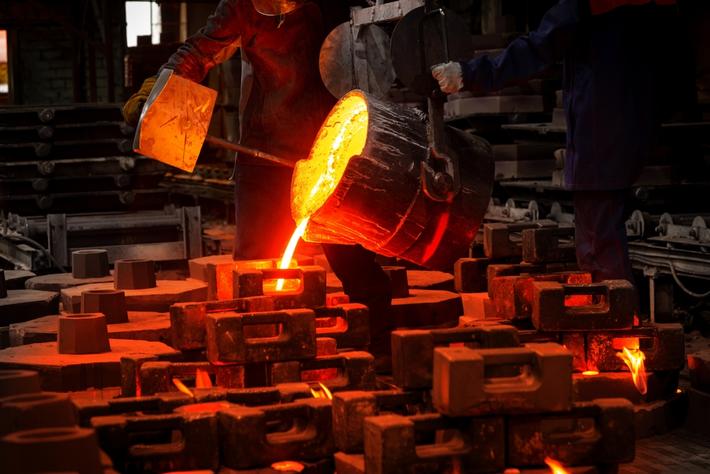
Foundry crisis 2024: serious suffering in the third quarter
The third quarter of 2024 marks a clear deterioration for the foundry sector, with a loss of production levels of -13.7% compared to the same period in 2023 and a cyclical decline in the second quarter that reaches -19%. While the cyclical loss is certainly affected by the seasonality of the month of August, it should be noted that the decline highlighted in the period from July to September follows a negative value of -2.1% already present between the second and first quarter of the year.
Similarly, turnover also records a trend contraction of -12% and a cyclical decline of -17.7%.
The data emerging from the latest economic survey by the Assofond Study Center for the period July-September 2024 highlight a dynamic of great difficulty, which, for several companies, is worse than the general averages of the sector.
«The data on the trend of the third quarter hide important internal differences between the foundry sectors – underlines the president of Assofond, Fabio Zanardi – From what emerges from the survey, the companies that work mainly for the automotive sector could still benefit, in the period considered, from an overall acceptable demand, while the foundries that produce products for mechanics, agricultural machinery, earthmoving, construction have seen a crisis that was already evident in the previous months worsen, with drops in both production and turnover in some cases close to or greater than -30%. Something that has not been seen since the financial crisis of 2008-2009. However, it should be noted that, starting from the last quarter, the automotive sector has also entered a phase of severe crisis. Considering this evolution, it is likely that the current overall figure for the foundry sector is close to -30%, confirming the alarm for the entire supply chain".
Production and turnover: performance difference between foundry sectors
The ferrous foundries are the ones that have the greatest gap with respect to last year's results: the trend loss is equal to -15.7%, against the -9.5% of non-ferrous foundries. Even on the economic data, the decline of non-ferrous foundries is lower (-17.3%) although only slightly, than the decline of ferrous foundries (-19.8%). The dynamics over the last four quarters also show a clear difference between the two underlying sectors, a figure that confirms the role played by the automotive sector: the trend production of non-ferrous foundries - which allocate more than 50% of their products to the automotive sector - does indeed record a setback, but after two quarters in which a positive sign was observed. The same curve, on the ferrous foundries side, has instead been continuously decreasing since the last quarter of 2023 and, in the latter, a new absolute minimum value is recorded.
91% of the sample considered by the Assofond survey on foundries in 2024 recorded a drop in production compared to the previous quarter. The seasonal variable (in August most companies stop production for several weeks) naturally had an impact, but much less than in the past: while 52% of the companies that responded to the questionnaire indicated the lower number of days worked as the main cause of the drop in production, 48% instead highlighted a drop in demand.
Also from the point of view of turnover, the loss in the same quarter of 2023 is more significant among ferrous foundries (-13.9%) and less so for non-ferrous ones (-8.2%); the cyclical decline of non-ferrous foundries stops at -14.9%, almost five points less than that of ferrous foundries (-19.1%).
Climate of confidence for the foundry sectors
In September, the Act index, which measures the general sentiment of the sector over the reference period, stands at 41.2 points. Although the figure is slightly improved compared to the previous month, the latest survey also returns a negative assessment, as has happened in all the last six months, a period during which the foundries have never assumed a positive assessment: the index has in fact never been above 50 points. The Six index, which measures the expectations of companies for the following six months, also remains below the sufficiency threshold (41.2 points) and in this case reaches the lowest value of the last six months.
"The global scenario remains uncertain - Zanardi comments - and Europe, at this moment, plays the part of the proverbial earthenware pot: the productivity gap that we pay compared to the major world economic powers is very large and is the result of years of lack of investment. Today the biggest scarecrow is the duties that we all expect will be decided by the Trump administration after his inauguration. However, we do not believe that protectionist policies by the USA can have a strong impact on our specific sector: even without barriers, in fact, we cannot today be truly competitive with American, or Chinese, or Indian competitors, who pay infinitely less for energy than us and who also have a lower incidence of labor costs. The only way to save our industry is the one indicated by the "Draghi report": increase European competitiveness and productivity through large investments. Vice versa, we can only witness the progressive industrial desertification of the EU".
Source: In Fonderia – Il magazine dell’industria fusoria italiana


